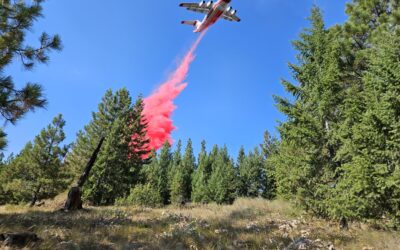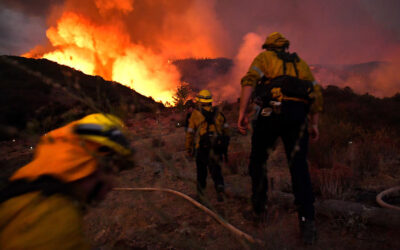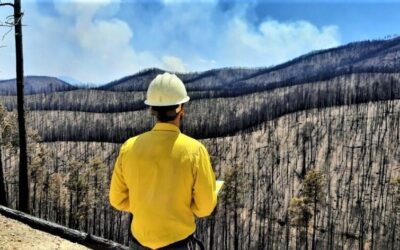A look at research into a better shelter

By Dena Ali | FireRescue Magazine
During my recent research project on climate change and wildfires, I learned that the fire shelters that wildland firefighters carry are not capable of protecting them from flames and high temperatures. This reality was demonstrated on June 30th, 2013, when extreme weather caused wind direction to shift 180 degrees, wind gusts of 60mph, and a fast approaching flame front that forced 19 trapped Granite Mountain Hotshots to deploy their shelters. Though this elite team of wildland firefighters deployed their shelters correctly, they all perished. Their shelters were not designed to withstand that intense amount of heat or fire.
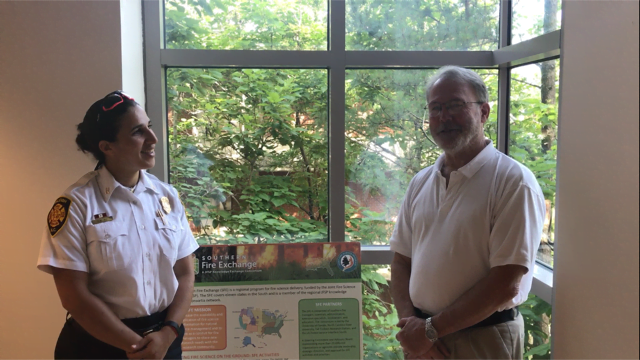
Captain Dena Ali and Dr. Joseph Roise, PhD, discuss the latest in new fire shelter testing. (author photo)
Second Generation Fire Shelters
Today’s second generation fire shelters have been standard equipment since 2002, when the Forest Service selected the New Generation Fire Shelter. According to the Forest Service, these shelters have a capacity to withstand approximately 500 degrees Fahrenheit. That’s the temperature where the weakest component of the shelter, the adhesive that binds the inner and outer layer, will start to fail. Although the foil that comprises the outer layer can sustain up to 1300 degrees, the shelter loses its effectiveness once the adhesive melts and the outer layer separates.

Multilayered prototype being tested by NCSU with a focus on the adhesive binding. (author photo)
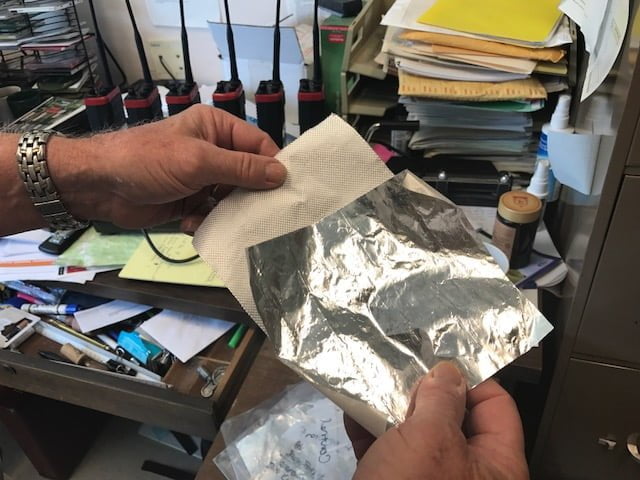
Current second generation fire shelter approved by the forest service in 2002 (author photo)
FEMA Assistance to Firefighters Grant
North Carolina State University (NCSU) is working under a FEMA grant to help produce a fire shelter that can perform better under heat and stress. In fact, they’re in a friendly competition with NASA’s Langley Research Center to produce a lightweight fire shelter designed to withstand higher temperatures for longer periods of time. They hope to produce a shelter that will protect future wildland firefighters who become trapped.
Building a Better Fire Shelter, NC State
Joseph Roise, PhD, is a professor in the Department of Forestry and Environmental Resources at NCSU. His department is working closely with the College of Textiles, Textile Protection and Comfort Center (T-PACC), on the project. Dr. Roise says his department is fortunate to work with the T-PACC team due to their expertise on materials and their experience working with firefighter PPE. The College of Textiles at NCSU is recognized worldwide as the global leader on textile innovation. By focusing on improving the seams and the adhesives of the shelter, Dr. Roise is confident that textile engineering will give them an advantage at producing the best product to save lives.
Interview with Dr. Roise, PhD
Summer 2017 Field Testing
Dr. Roise’s team has narrowed their focus down to two prototypes that they will continue evaluating over the summer. He notes that the most challenging aspects of their project are strengthening the seams, enhanced materials, improving heat blocking properties, and keeping the product light. They lab-tested the shelters in a fire chamber on campus and are now field-testing the prototypes. They have already successfully tested them in the tall grass species of South Dakota, Chaparral grass in California, and Longleaf Pine/wire grass in North Carolina. They’ll continue testing with other fuel types, including the highly-flammable pocosin fuels in Virginia, southern rough/pine in North Florida, and the boreal forests of Canada’s Northwest Territories.
Fire Shelter Test No.3, Joseph Roise
The team hopes to their prototype will be ready for presentation by the end of the year.
Additional Information:
InciWeb: The Future of Fire Shelters
DENA M. ALI is a Captain with the Raleigh (NC) Fire Department and an EMT Intermediate with Wake County (NC) EMS. She has a bachelor’s degree from North Carolina State University, and is a graduate student at the University of North Carolina, Pembroke, where she is pursuing a degree in public administration. She is a founding member of the Carolina Brotherhood and a fitness advocate with 555 Fitness.

